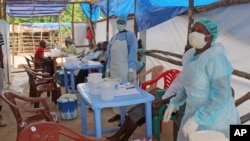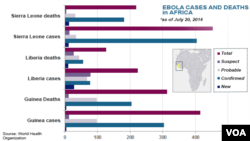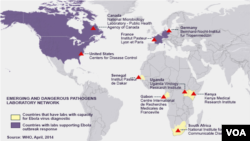Health authorities across West Africa are trying to identify airline passengers who had contact with a man who died of Ebola.
Patrick Sawyer boarded a flight in Liberia, had a layover in Ghana, and changed planes in Togo for a flight to Lagos, Nigeria where he died Friday of the virus.
Sawyer was immediately quarantined when he arrived in Nigeria, but other passengers were allowed to leave the airport after they were told about the Ebola outbreak.
The West African airline that Sawyer flew on has suspended its operations in Monrovia, Liberia and Freetown, Sierra Leone - two cities affected by the outbreak.
Arik Airlines said Tuesday its flights to the cities would be suspended until further notice as a result of the confirmed Ebola death in Lagos, Nigeria.
World Health Organization [WHO] spokesman Paul Garwood said because of the close proximity of countries in the region, an effective response to the outbreak must include contact tracing and lab testing.
"We understand that in this part of the world, the borders are very, very porous, so it's quite easy for people to cross from one country into another, without detection, without using a regular border crossing," said Garwood.
Sawyer worked for Liberia's Finance Ministry and was headed to Nigeria for a conference.
Witnesses said Sawyer appeared to be ill on at least one of his flights.
But health experts say that is not necessarily enough to infect others. Contracting Ebola requires direct contact with infected bodily fluids.
WHO says Ebola has killed at least 672 people in West Africa. The majority of deaths are in Guinea.
In a report updated on Saturday, WHO said 319 people had died from Ebola in Guinea. The health organization reported 224 deaths in Sierra Leone and 129 in Liberia.
One of Liberia’s top doctors, who was treating Ebola patients, died from the disease last week. Two American doctors and a doctor from Sierra Leone have also contracted the virus, sparking fear about the safety of health workers.
There is no cure or vaccine for Ebola, which causes symptoms that include fever, vomiting, diarrhea and unstoppable bleeding.
Ebola Factbox
Ebola Factbox
Outbreaks of Ebola are life-threatening and in up to 90% of cases, people die.
- In most instances, outbreaks have occurred in remote villages of Central andWest Africa, close to tropical rainforests
- The virus is transmitted to humans from wild animals and spreads human-to-human through exposure to organs, blood and other bodily fluids
- Presently no specific treatment or vaccine is available for people, nor for animals
Content sourced from World Health Organization
On saturday, More than 10,000 people in Liberia's capital protested the opening of a new Ebola isolation unit in their community. Liberia’s Ministry of Health said the center is essential for fighting the Ebola outbreak and that Liberians need to start trusting health workers.
But residents say they do not want a new isolation unit planned by U.S.-based NGO Samaritan’s Purse plans to open at ELWA Hospital, on the outskirts of Monrovia.
Milane Norris lives near the ELWA hospital. He says, “I’m afraid because if the government sets up this testing center here, definitely I will be able to get this disease. So we are saying that the government shouldn’t set up the testing center in ELWA area. We are afraid. We don’t want to die. ”
Norris, like many Liberians, continues to believe that foreign doctors who have been responding to the outbreak and treating suspected cases are the ones responsible for its spread.
This, despite mass education campaigns about the modes of transmission and the importance of seeking medical care.
Liberia’s Minister of Health, Walter Gwenigale, explained why many people continue to hide from “real” doctors.
“There are still people in our community who are saying that say this disease is not here, that we did this just to get money," he said. "The other reason the disease is spreading is resistance to carry out the things we are telling people not to do. Some people are fearing because they don’t want to be injected, they think that they will die, and so are afraid to come to us.”
Monrovian resident Morris Moore says traditional healers can protect him from Ebola in ways that medical science can not.
“I believe personally that the witchdoctor has a cure for this disease," he said. "I know many people would think that it is not possible, but I know they are just fooling themselves. So I will go to the witchdoctor and if I go to the witchdoctor, I will be well. I will not contract the disease.”
But Liberian doctor Benedict Wolor warns that such ideas are foolish and should be rejected.
“This is a disease…Witchdoctors have no cure," he said. "If you see people going around saying they’ve got a vaccine or medicine that a witchdoctor thinks he can use to cure or a prayer method, they should be arrested. People should not go there. Ebola is no joke. It’s real.”
Liberia’s President Ellen Johnson Sirleaf closed many of the country's land borders on Sunday and has restricted public gatherings. All arriving and departing airline passengers in Liberia are now being inspected for signs of Ebola.
Jennifer Lazula in Dakar and Prince Collins in Monrovia contributed to this report.












